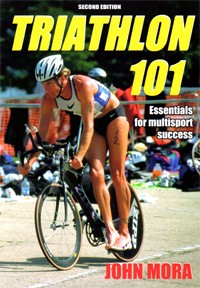 |
|
Fitness Tip of the Day!
|
|
Determining Your Foot Anatomy
|
|
An easy way to determine whether you are a pronator or a supinator or somewhere in between is to simply moisten the bottom of your bare foot and then stand on a flattened brown paper bag. The resulting silhouette will tell you the answer.
|
|
 |
 |
 |
|
 |
|
|
Triathlon 101, 2nd. ed.
|

|
| Author: |
Mora J |
| Category: |
Sports Performance |
| Audience: |
Consumer |
| Length: |
189 pages |
| Publisher: |
Human Kinetics |
| Year Published: |
2009 |
| List Price: |
$18.95 |
|
|
|
|
AthleteInMe.com®
Rating:



 Excellent!
Excellent!
Triathlon 101 is a training guide for those new to triathlon. It is now in its 2nd edition.
Recommended for: beginning triathletes.
ABOUT THE AUTHOR
John Mora is a fitness writer; he has published more than 500 articles. He is the running columnist and triathlon feature writer for Windy City Sports (Chicago) and was formerly a contributing editor for Triathlete magazine. He has been competing in triathlons since 1988 and has participated in nearly 200 running, cycling, and swimming events, including marathons, sprint triathlons, and the Ironman competition.
CONTENT
The 189 page text is organized as follows:
PART I: Getting Ready To Tri
- Chapter 1: So You Wanna Tri?
- Chapter 2: Planning To Race
- Chapter 3: Getting the Right Stuff
PART II: Triathlon Training Basics
- Chapter 4: Swim Training: The Key Is Technique
- Chapter 5: Bike Training: Putting in the Mileage
- Chapter 6: Run Training: Putting One Foot in Front of the Other
- Chapter 7: Training for All Three
PART III: Tri-ing Your Best
- Chapter 8: Fueling Up for Triathlon
- Chapter 9: Staying Healthy
- Chapter 10: Peaking to Race
- Chapter 11: Nailing the Big Day
- Chapter 12: Tri, Tri Again
REVIEW
In short, this book is excellent....one of the 2 best training guides for the triathlon we have seen (the other one we really liked is The Woman Triathlete by Christina Gandolfo and other authors). In Triathlon 101, Mora covers every aspect of triathlon training. His writing style is a nice balance between explaining the concepts while keeping the text easy to read. The 2nd edition of Triathlon 101 has been enhanced by the inclusion of large, color pictures of actual triathletes in various stages of competition. The page layout throughout the book is also made more appealing by the use of a variety of useful tables.
• What We Liked: Triathlon 101 is a great resource for the beginning triathlete. All of the important concepts are covered in an easy-to-read style.
• What Could Be Better: The only flaw in this book is when the author delves into nutrition and supplements. For example, on p. 122, the author has reproduced an educational guide on the Nutrition Facts food label from the FDA. The statement "Limit sodium to help reduce your risk of high blood pressure" appears. In general, this is good advice, however, in most triathlons, competitors are going to be perspiring heavily. Thus, they should probably increase, not decrease, their sodium intake. Hyponatremia has been reported in marathon runners who consumed too much plain water. On p. 168, he recommends that triathletes take vitamins and supplements. Not only is this probably not necessary, it contradicts his warning on p. 123 about consuming vitamins and supplements.
SUMMARY
We can highly recommend this book. Beginning triathletes should start with this book, and then consider reading The Woman Triathlete by Christina Gandolfo, as it offers additional info on triathlon gear.
| Reviewed by: Stan Reents, PharmD |
4/5/2017 8:13:56 AM |
|
|
 |
|
 |
|
|
|
 |
 |